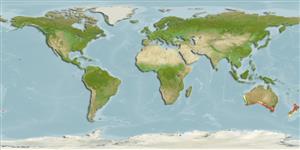Environment: milieu / climate zone / depth range / distribution range
पारिस्थितिकी
समुद्री ड़िमरसल; गहराई सीमा 20 - 160 m (Ref. 9563). Temperate
Eastern Indian Ocean and Southwest Pacific: southern Australia (from South Australia to New South Wales and Tasmania) and New Zealand (Ref. 5755).
आकार / वज़न / Age
Maturity: Lm ? range ? - ? cm
Max length : 65.0 cm TL पुल्लिंग / अलिंग; (Ref. 9563)
Occurs on the continental shelf (Ref. 9563).
Life cycle and mating behavior
Maturities | पुनरुत्पत्ति | Spawnings | Egg(s) | Fecundities | लार्वा
May, J.L. and J.G.H. Maxwell, 1986. Trawl fish from temperate waters of Australia. CSIRO Division of Fisheries Research, Tasmania. 492 p. (Ref. 9563)
IUCN Red List Status (Ref. 130435)
Threat to humans
Harmless
Human uses
मात्स्यिकी: व्यापारिक
साधन
Special reports
Download XML
इंटरनेट स्रोत
Estimates based on models
Preferred temperature (Ref.
123201): 13.9 - 21.2, mean 16 °C (based on 156 cells).
Phylogenetic diversity index (Ref.
82804): PD
50 = 0.7812 [Uniqueness, from 0.5 = low to 2.0 = high].
Bayesian length-weight: a=0.01175 (0.00560 - 0.02463), b=3.04 (2.86 - 3.22), in cm total length, based on LWR estimates for this (Sub)family-body shape (Ref.
93245).
Trophic level (Ref.
69278): 3.4 ±0.2 se; based on size and trophs of closest relatives
लौटाव (Ref.
120179): निम्न, न्यूनतम जनसंख्या दुगनी होने का समय 4.5 - 14 वर्ष। (Preliminary K or Fecundity.).
Fishing Vulnerability (Ref.
59153): Moderate to high vulnerability (46 of 100).
Nutrients (Ref.
124155): Calcium = 31.4 [20.6, 60.6] mg/100g; Iron = 0.396 [0.250, 0.659] mg/100g; Protein = 18.4 [17.5, 19.2] %; Omega3 = 0.576 [0.351, 0.920] g/100g; Selenium = 15.8 [8.3, 30.4] μg/100g; VitaminA = 15.3 [4.8, 48.7] μg/100g; Zinc = 0.487 [0.361, 0.670] mg/100g (wet weight);
